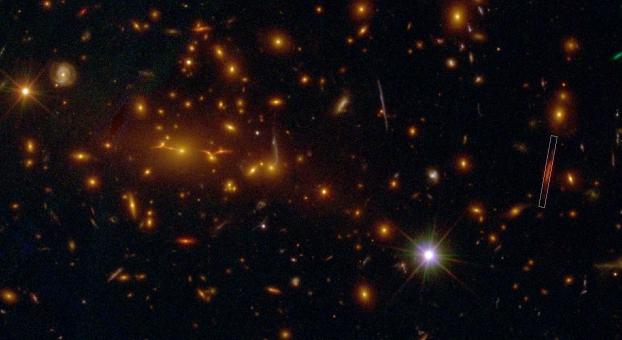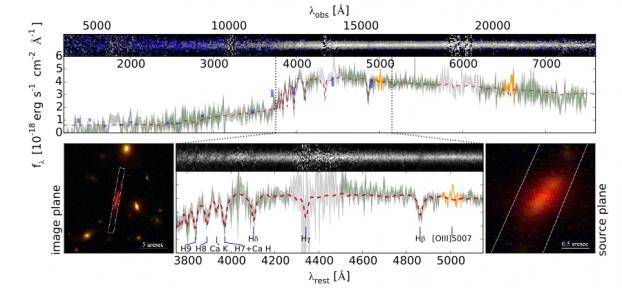A Massive Dead Disk Galaxy Challenges Theories of Galaxy Evolution
A young, compact and “dead” disc galaxy surprises the astronomers and teaches us more about the formation of elliptical galaxies.
By combining the power of a “natural lens” in space with the capability of NASA’s Hubble Space Telescope, astronomers of several international laboratories (including the Institut de Recherche en Astrophysique et Planétologie (IRAP) at Toulouse (Université Toulouse 3 Paul Sabatier/CNRS) and the Centre de Recherche Astrophysique (CRAL) of Lyon (Univesité Claude Bernard Lyon 1/ENS Lyon/CNRS) made a surprising discovery—the first example of a compact yet massive, fast-spinning, disk-shaped galaxy that stopped making stars only a few billion years after the big bang. This is called a “dead” galaxy because it no longer gives birth to new stars. Finding a galaxy in the shape of a pancake – physically resembling the Milky Way – dead so prematurely in the history of the Universe, challenges the current understanding of how massive galaxies form and evolve. Indeed the Universe at that time was filled with gas and was at the maximum of its history of stellar formation.
The dominant theory to explain such a stopping of the formation of stars is the fusion of galaxies. This fusion would form more massive, elliptical and dead galaxies. Until then, this scenario was the most compatible with the observations.

The idea that galaxies could die before undergoing a fusion scenario seemed unthinkable from a theoretical point of view. The team of researchers studied galaxies of the young and distant universe to confirm the theories. In order to be able to see so far, it is necessary to use telescopes even more powerful than those currently available on Earth and in space. The phenomenon known as the effect of “gravitational lenses” effect caused by clusters of galaxies, makes it possible to obtain the same effect as the one produced by telescopes. It amplifies and stretches the images of distant galaxies located near a cluster of massive galaxies. The use of these “natural telescopes” allowed scientists to study in detail one of these dead galaxies. While they expected to see a chaotic set of stars formed by fusions of galaxies (as in an elliptical galaxy), against all odds they saw a distribution of rotating disc-shaped stars. This galaxy is three times as massive as our Milky Way but has only half its size. Rotation speed measurements taken with the Very Large Telescope (VLT) of the European Southern Observatory (ESO) show that this disk rotates twice as fast as the Milky Way.
It is an observational proof that at least a fraction of the very first “dead” galaxies have had to evolve greatly, modifying not only their structure but the movements of their stars, leading to the current elliptic giant galaxies. Astronomers were able to see that the formation of stars stopped first in the center of the galaxy and then gradually towards the outside. The reason for this stopping of star formation is not known, and can come from an active core galaxy to the core, whose energy source is a supermassive black hole that inhibits the formation of stars. Or it may come from the heating of the gas going to the core of the galaxy, preventing it from reaching it and transforming it into clouds of dense molecular gas.

This new discovery could force the scientific community to partly reconsider their vision of the evolution of galaxies. How do young, massive, compact galaxies evolve towards elliptic galaxies? Probably not by a large number of mergers. If these galaxies merge with less massive companions in large numbers and coming from all directions, or undergo a major fusion, this would disrupt the orbits of stars in galaxies.
Further Resources
- Scientific article : Sune Toft, Johannes Zabl, Johan Richard, Anna Gallazzi, Stefano Zibetti, Moire Prescott, Claudio Grillo, Allison W. S. Man, Nicholas Y. Lee, Carlos Gómez-Guijarro, Mikkel Stockmann, Georgios Magdis & Charles L. Steinhardt, A massive, dead disk galaxy in the early Universe. Nature 546, 510–513, Juin 2017. doi:10.1038/nature22388
- NASA Press Release : Hubble Captures Massive Dead Disk Galaxy that Challenges Theories of Galaxy Evolution
IRAP Contact
- Johannes Zabl, johannes.zabl@irap.omp.eu






